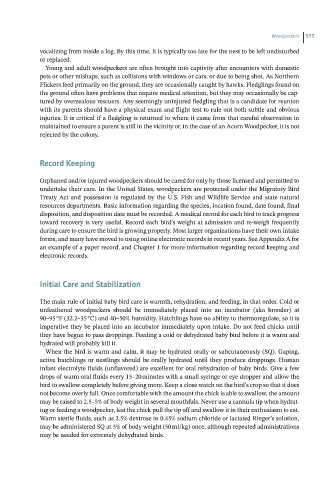Page 576 - Hand rearing birds second
P. 576
Woodpeckers 577
vocalizing from inside a log. By this time, it is typically too late for the nest to be left undisturbed
or replaced.
Young and adult woodpeckers are often brought into captivity after encounters with domestic
pets or other mishaps, such as collisions with windows or cars, or due to being shot. As Northern
Flickers feed primarily on the ground, they are occasionally caught by hawks. Fledglings found on
the ground often have problems that require medical attention, but they may occasionally be cap-
tured by overzealous rescuers. Any seemingly uninjured fledgling that is a candidate for reunion
with its parents should have a physical exam and flight test to rule out both subtle and obvious
injuries. It is critical if a fledgling is returned to where it came from that careful observation in
maintained to ensure a parent is still in the vicinity or, in the case of an Acorn Woodpecker, it is not
rejected by the colony.
RecordKeeping
Orphaned and/or injured woodpeckers should be cared for only by those licensed and permitted to
undertake their care. In the United States, woodpeckers are protected under the Migratory Bird
Treaty Act and possession is regulated by the U.S. Fish and Wildlife Service and state natural
resources departments. Basic information regarding the species, location found, date found, final
disposition, and disposition date must be recorded. A medical record for each bird to track progress
toward recovery is very useful. Record each bird’s weight at admission and re‐weigh frequently
during care to ensure the bird is growing properly. Most larger organizations have their own intake
forms, and many have moved to using online electronic records in recent years. See Appendix A for
an example of a paper record, and Chapter 1 for more information regarding record keeping and
electronic records.
InitialCareand Stabilization
The main rule of initial baby bird care is warmth, rehydration, and feeding, in that order. Cold or
unfeathered woodpeckers should be immediately placed into an incubator (aka brooder) at
90–95 °F (32.2–35 °C) and 40–50% humidity. Hatchlings have no ability to thermoregulate, so it is
imperative they be placed into an incubator immediately upon intake. Do not feed chicks until
they have begun to pass droppings. Feeding a cold or dehydrated baby bird before it is warm and
hydrated will probably kill it.
When the bird is warm and calm, it may be hydrated orally or subcutaneously (SQ). Gaping,
active hatchlings or nestlings should be orally hydrated until they produce droppings. Human
infant electrolyte fluids (unflavored) are excellent for oral rehydration of baby birds. Give a few
drops of warm oral fluids every 15–20 minutes with a small syringe or eye dropper and allow the
bird to swallow completely before giving more. Keep a close watch on the bird’s crop so that it does
not become overly full. Once comfortable with the amount the chick is able to swallow, the amount
may be raised to 2.5–5% of body weight in several mouthfuls. Never use a cannula tip when hydrat-
ing or feeding a woodpecker, lest the chick pull the tip off and swallow it in their enthusiasm to eat.
Warm sterile fluids, such as 2.5% dextrose in 0.45% sodium chloride or lactated Ringer’s solution,
may be administered SQ at 5% of body weight (50 ml/kg) once, although repeated administrations
may be needed for extremely dehydrated birds.

